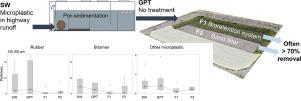Water Research ( IF 12.8 ) Pub Date : 2021-07-23 , DOI: 10.1016/j.watres.2021.117457 Katharina Lange 1 , Kerstin Magnusson 2 , Maria Viklander 1 , Godecke-Tobias Blecken 1

|
Microplastic particles in stormwater pose significant threats to the environment. This study investigated how effective a stormwater treatment train was at removing rubber, bitumen and other microplastics (incl. fibers, fragments, and paint particles) in the 100–300 µm and >300 µm size fractions from highway runoff. The two treatment trains comprise a gross pollutant trap (GPT) followed by either a vegetated bioretention cell or non-vegetated sand filter. Flow-proportional composite samples were taken from the highway runoff, GPT outflow and the outflow from the two parallel filters during nine rain events to determine overall treatment performance, as well as the performance of individual system components. The identified rubber, bitumen and other microplastic particles mainly represented the 100–300 µm fraction and included high ratios of rubber (30%) and bitumen (60%). Overall, the treatment train efficiently removed rubber, bitumen and other microplastic particles in the 100–300 µm size fraction from the stormwater. The filter cells accounted for a major share of this removal, as the GPT did not reduce microplastic particle concentrations. This observation is likely explained by the fact that the rubber, bitumen and other microplastic particles have a density close to the density of water and thus removal by sedimentation is decreased. This identified an inherent weakness of the system; more specifically, the high microplastic concentrations in the surface water of the GPT means there can be a risk of microplastic release through overflow pits when inflows surpass the system capacity. Despite some differences, both the vegetated bioretention cell and the non-vegetated sand filter removed rubber, bitumen and other microplastic particles to similar extent.
中文翻译:

通过总污染物捕集器-生物滞留处理列车从雨水中去除橡胶、沥青和其他微塑料颗粒
雨水中的微塑料颗粒对环境构成重大威胁。本研究调查了雨水处理系统在从公路径流中去除 100–300 µm 和 >300 µm 粒径部分的橡胶、沥青和其他微塑料(包括纤维、碎片和油漆颗粒)方面的效果。两个处理序列包括一个总污染物捕集器 (GPT),然后是一个植被生物滞留池或非植被砂滤器。在九次降雨事件期间,从高速公路径流、GPT 流出和两个平行过滤器的流出中获取流量比例复合样本,以确定整体处理性能以及各个系统组件的性能。经鉴定的橡胶,沥青和其他微塑料颗粒主要代表 100-300 µm 的部分,包括高比例的橡胶 (30%) 和沥青 (60%)。总体而言,处理系统有效地从雨水中去除了 100-300 微米大小的橡胶、沥青和其他微塑料颗粒。由于 GPT 没有降低微塑料颗粒浓度,因此过滤器单元在去除过程中占了很大比例。这一观察结果可能是由于橡胶、沥青和其他微塑料颗粒的密度接近水的密度,因此通过沉淀去除的减少。这确定了系统的固有弱点;进一步来说,GPT 地表水中的高微塑料浓度意味着当流入量超过系统容量时,微塑料可能会通过溢流坑释放。尽管存在一些差异,但植被生物滞留池和非植被砂滤器在相似程度上去除了橡胶、沥青和其他微塑料颗粒。



























 京公网安备 11010802027423号
京公网安备 11010802027423号